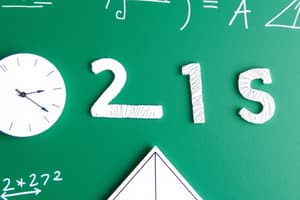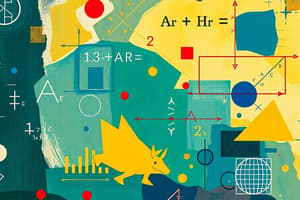Podcast
Questions and Answers
Which of the following operations follows the order of operations known as PEMDAS?
Which of the following operations follows the order of operations known as PEMDAS?
- $2 + 3 imes 4$
- $6 + 4 imes (2 - 1)$
- $3 imes (2 + 4) - 1$
- $(8 - 2) imes 5$ (correct)
What is the area of a triangle with a base of 10 units and a height of 5 units?
What is the area of a triangle with a base of 10 units and a height of 5 units?
- 25 square units (correct)
- 30 square units
- 15 square units
- 50 square units
Which of the following describes a sine function in trigonometry?
Which of the following describes a sine function in trigonometry?
- It represents the ratio of the opposite side to the adjacent side.
- It represents the ratio of the adjacent side to the opposite side.
- It represents the ratio of the opposite side to the hypotenuse. (correct)
- It represents the ratio of the adjacent side to the hypotenuse.
When calculating the derivative of a function, which rule is applied to find the derivative of a product of two functions?
When calculating the derivative of a function, which rule is applied to find the derivative of a product of two functions?
What is the median of the following set of numbers: 3, 1, 4, 2, 5?
What is the median of the following set of numbers: 3, 1, 4, 2, 5?
Which of the following is a fundamental concept in discrete mathematics?
Which of the following is a fundamental concept in discrete mathematics?
Which theorem can be used to find the length of the hypotenuse of a right triangle?
Which theorem can be used to find the length of the hypotenuse of a right triangle?
What is the correct definition of a probability distribution?
What is the correct definition of a probability distribution?
Which of the following is a common method for proving mathematical statements?
Which of the following is a common method for proving mathematical statements?
Which of the following represents an inequality?
Which of the following represents an inequality?
Flashcards are hidden until you start studying
Study Notes
Key Areas in Mathematics
-
Arithmetic
- Basic operations: Addition, Subtraction, Multiplication, Division
- Order of operations (PEMDAS/BODMAS)
- Fractions, decimals, percentages
-
Algebra
- Variables and constants
- Expressions, equations, and inequalities
- Functions and graphs
- Solving linear and quadratic equations
-
Geometry
- Basic shapes (triangles, squares, circles)
- Properties of angles, lines, and polygons
- Perimeter, area, and volume calculations
- Theorems (Pythagorean theorem, properties of parallel lines)
-
Trigonometry
- Sine, Cosine, Tangent functions
- Relationships between angles and sides of triangles
- Unit circle and radians
- Applications in real-world scenarios (e.g., navigation, physics)
-
Calculus
- Limits and continuity
- Derivatives and their applications
- Integrals and the Fundamental Theorem of Calculus
- Applications in motion, area under curves
-
Statistics
- Descriptive statistics: mean, median, mode
- Probability concepts and rules
- Distributions (normal, binomial, etc.)
- Inferential statistics: hypothesis testing, confidence intervals
-
Discrete Mathematics
- Sets, relations, and functions
- Graph theory (vertices, edges, paths)
- Combinatorics (permutations, combinations)
- Algorithms and complexity
-
Mathematical Reasoning
- Logical statements and truth values
- Proof techniques (direct, contradiction, induction)
- Problem-solving strategies
Important Concepts
- Number theory (prime numbers, divisibility)
- Mathematical models (using math to represent real-world situations)
- Use of technology (calculators, software for complex calculations)
Study Tips
- Practice regularly: Work through problems and exercises.
- Understand concepts: Focus on why methods work, not just how.
- Visual aids: Use diagrams and graphs to aid understanding.
- Group study: Discussing problems with peers can enhance comprehension.
- Resources: Utilize textbooks, online tutorials, and math software.
Key Areas in Mathematics
-
Arithmetic: Involves basic operations including addition, subtraction, multiplication, and division; utilizes order of operations (PEMDAS/BODMAS) for problem-solving; includes concepts of fractions, decimals, and percentages for numerical manipulation.
-
Algebra: Focuses on variables and constants, expressions, equations, and inequalities; emphasizes understanding functions and their graphical representations; teaches methods for solving linear and quadratic equations.
-
Geometry: Examines basic shapes such as triangles, squares, and circles; explores properties of angles, lines, and polygons; includes calculations of perimeter, area, and volume; applies theorems like the Pythagorean theorem and properties of parallel lines for geometric reasoning.
-
Trigonometry: Centers on sine, cosine, and tangent functions; investigates relationships between angles and sides in triangles; introduces the unit circle and the use of radians; applies concepts to real-world scenarios such as navigation and physics.
-
Calculus: Covers limits and the concept of continuity; focuses on derivatives and their applications in various problems; explores integrals and the Fundamental Theorem of Calculus; uses calculus in practical applications like motion analysis and finding areas under curves.
-
Statistics: Encompasses descriptive statistics such as mean, median, and mode; introduces probability concepts and related rules for assessing likelihood; examines different distributions like normal and binomial; discusses inferential statistics including hypothesis testing and confidence intervals to draw conclusions from data.
-
Discrete Mathematics: Investigates sets, relations, and functions; delves into graph theory by studying vertices, edges, and paths; explores combinatorial methods including permutations and combinations; covers algorithms and their complexity for efficient problem-solving.
-
Mathematical Reasoning: Focuses on logical statements and their truth values; teaches proof techniques including direct proofs, proof by contradiction, and mathematical induction; emphasizes problem-solving strategies for tackling complex mathematical challenges.
Important Concepts
-
Number Theory: Includes study of prime numbers, divisibility rules, and integer properties that are foundational in mathematics.
-
Mathematical Models: Utilizes mathematics to represent and analyze real-world situations, aiding in predictions and decision-making.
-
Use of Technology: Incorporates tools such as calculators and mathematical software for performing complex calculations and enhancing learning experiences.
Study Tips
-
Practice Regularly: Engage in problem-solving exercises to reinforce understanding and improve proficiency.
-
Understand Concepts: Focus on the rationale behind mathematical methods, promoting deeper comprehension beyond procedural knowledge.
-
Visual Aids: Employ diagrams and graphs to clarify and support mathematical concepts effectively.
-
Group Study: Collaborative learning with peers can enhance understanding and offer diverse perspectives on problem-solving.
-
Resources: Utilize a variety of educational materials including textbooks, online tutorials, and software to solidify knowledge and skills in mathematics.
Studying That Suits You
Use AI to generate personalized quizzes and flashcards to suit your learning preferences.




